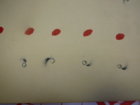In an earlier post, received from a Berger bullet ballistic engineer and from looking at Sg calculations the length of the plastic tip is subtracted - JBM - calculations - stability. Apparently, JBM and others think that the plastic tip being much lighter than the other parts of the bullet has no effect in moving the bullets center of mass forward. JBM, using the Miller stability calculator, has provisions for plastic tip length. I think there is some validity for the subtraction of the plastic tip length because my use of the 75 grain Amax and ELDM in 7.7 & 8 twist barrels has worked out real well at all ranges. Measuring the entire works gives an Sg in the marginal stability range; not that Sg values are an absolute indicator of stability but certainly provide a good indicator. Pursuing this point (pun?) further the Berger stability program shows that optimum ballistic performance is derived from a certain relationship between bullet length and twist rate. The same stability indicators are to be found in the Hornady 4 degree calculator.
Adding tin to the core alloy would make that alloy sort of a solder - sticky upon heat. Brass, an alloy of copper and zinc, is electro-plateable and jacket alloy should be similar. I remember shooting some Remington Power Lockt (??) bullets that were electro plated then had the points modified to make a shallow hollow point having expansion cuts up near the bullet point. The point of all this being to make a lead core bullet sort of a semi monolithic type, this might mitigate some bullet blow-ups.
I am in complete agreement on the patent business - a family member came up with about 100 patents for various organic chemical processes with the expectation that some serious big fund research would run into one of his patents requiring some buy out. As far as I know, he never got a hit. Sort of like traps around some eatable goodie to trap a wolf.
Adding tin to the core alloy would make that alloy sort of a solder - sticky upon heat. Brass, an alloy of copper and zinc, is electro-plateable and jacket alloy should be similar. I remember shooting some Remington Power Lockt (??) bullets that were electro plated then had the points modified to make a shallow hollow point having expansion cuts up near the bullet point. The point of all this being to make a lead core bullet sort of a semi monolithic type, this might mitigate some bullet blow-ups.
I am in complete agreement on the patent business - a family member came up with about 100 patents for various organic chemical processes with the expectation that some serious big fund research would run into one of his patents requiring some buy out. As far as I know, he never got a hit. Sort of like traps around some eatable goodie to trap a wolf.
Last edited:











